(click on photos to enlarge image)
THE HISTORY OF EARLY ENGLISH SILVER TEA EQUIPAGE
It has been said that there is more tea drunk in England
than in any other country in the world and tea is known as the
English national drink. It is difficult to know why this is but
it may be that tea was looked on in its early days as a status
symbol. When tea first came to England it was believed to have
medicinal properties and was very expensive so that it was only
drunk by the wealthy.
Another mystery surrounding the consumption of tea in England is
the way in which it is taken. Originally it was imported from
China and the Chinese did not, at the time, use dairy products
at all yet the English habitually put milk in their tea. It
cannot be established when exactly this practice started but it
was certainly well established by the 18th century. The
international traveller Per Kalm on a visit to England in 1748
wrote "most people pour a little cream or sweet milk into the
tea cup when they are about to drink the tea..."
(see note 1).
The first records of tea being drunk in England are a bit
sketchy but there is a record of tea being imported into London
as early as 1657 when the Dutch East India Company brought in a
small consignment using ships registered in England under the
Navigation Act of 1651
(see note 2). It was not until 1669 however that the
English East India Company began importing tea to London.
Tea was being advertised in London in 1658 and it is believed
that Thomas Garway (Garaway) served tea in his London coffee
house in that year. The following year, 1659, Thomas Rugge wrote:
"There were also at this time a Turkish drink to be solde,
almost in every street, called coffee, and another kind of drink
called tee,..."
(see note 3). The earliest actual record of tea being
drunk is in Pepys diary (his entry for 25th September 1660
records that he sent for "a cupp of tee, a China drink, of which
I never drank before" and it is known that Catherine of Braganza
brought a small casket of tea with her when she came to England
in 1662 to marry Charles II following his restoration to the
English throne in 1660. She was also given a present of some tea
in that year so that it can be said that it was a socially
accepted drink by the time of the 'Restoration').
Although it seems likely that the fact that Catherine drank tea
may have had an influence in making it popular it was originally
a male drink since it was served in the coffee houses of both
London and Oxford and these were male preserves. It was not
until the end of the 17th century that it found its way into the
private home.
There is no record known to this author of how the tea was
served in coffee houses or what equipment may have been used.
The first known tea pot, distinguishable as such by the
inscription on it which reads "This silver tea pott was
presented to ye Committee of ye East India Company by ye
Honourable George Lord Berkley of Berkley Castle. A member of
that Honourable and worthy Society and A true Hearty Lover of
them 1670", differs from the first known coffee pot dated London
1681 only in that the former is larger and has its handle at a
right angle to the spout whereas the latter has the two in a
straight line. They are both somewhat conical in form (Fig 1).
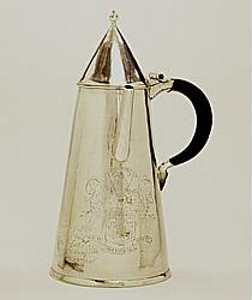
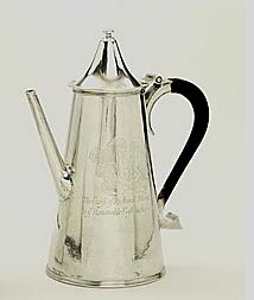
|
Fig 1: Earliest known tea pot and earliest known
coffee pot - late 17th century
(Courtesy Victoria and Albert Museum. London)
|
The earliest known tea spoon (fig 2), dated by its
provenance
(see note 4), must have been made before 1676 but as
small items of this sort were not hallmarked at the time it is
not possible to say when exactly or when 'tea tongs' (sugar
tongs) (fig 3) and 'long tea strained spoons with narrow pointed
handles' (mote spoons) (fig 4) were first made although it must
have been before 1700.
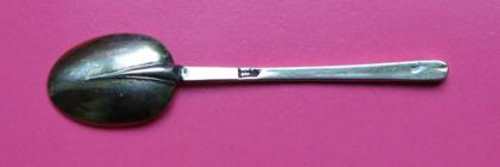
|
Fig 2: The earliest known English silver
teaspoon - c1670
(Courtesy The David Whitbread collection)
|

|
Fig 3: Andiron Tea Tongs by Abraham Harache -
late 17th century
|

|
Fig 4: Early 18th century Mote Spoon by William
Lutwich
|
The earliest known reference to a tea kettle (Fig 5) is of
one dated 1687 and the earliest extant example, now at the
Norwich Castle Museum, is dated 1694. It must have been somewhen
after 1670 therefore that tea drinking became a domestic rather
than a commercial pastime and well established as such by the
1690s since the purpose of the tea kettle with its stand and
spirit burner was to produce hot water at the table for a second
brew and this would have been a domestic necessity.
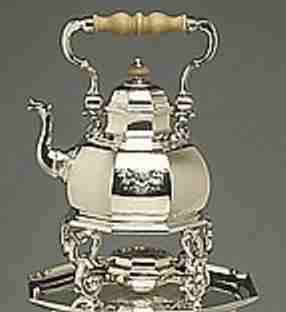
|
Fig 5: Tea Kettle on Stand by - early 18th
century
|
Not only was tea itself expensive but the equipment used in
its preparation was also expensive. A tea kettle and stand
supplied to a certain Oliver St. George Esq of Dublin in 1703 by
Peter Harache of London cost £23.18.00!
(see note 5)
By the beginning of the 18th century therefore the social habit
of tea drinking had become established and a suitable container
in which the tea could be kept had to be produced. This
container, known as a canister and later as a caddy (Fig 6),
took the form of a bottle shaped vessel with a narrow neck and a
pull off cap or lid. The tea was put into the canister by means
of a sliding base or sliding shoulder and taken from it by
dispensing it into the cap from the neck.
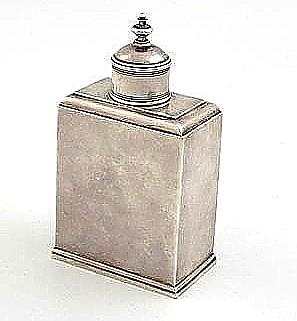
|
Fig 6: Tea canister by John Chatier - first
quarter on 18th century
(Courtesy of Woolley & Wallis - Auctioneers of
Salisbury)
|
The earliest pictorial representation of tea drinking in
England known to this author is a painting by Richard Collins of
about 1725. It shows the tea canister and next to it a hot milk
jug. This shows us that milk was taken with tea by the reign of
George I but that at this date it was served hot although in
1698 Rachel, Lady Russell mentions milk bottles used in
connection with tea implying that it was used cold
(see note 6). However it was roughly by the 1720s
that small jugs (Fig 7) started to be produced and although
these are usually referred to as cream jugs it is likely that
they were used for cold milk as well as for cream since the
larger lidded jugs with insulated handles used for hot milk are
not common after about 1720.

|
Fig 7: Sparrow Beak jug by an unidentified maker
- London 1728
|
By the end of the 17th century ceramic tableware was being
imported from China mostly, at that time, as ballast in ships.
The tea pots, used by the Chinese, which formed part of this
cargo were of a more spherical than conical shape and this form
was adopted by English silversmiths so that by the reign of
Queen Anne tea pots were easily distinguishable from coffee pots
which were still tall and, although shaped, narrower at the top
than at the bottom.
In the same way that milk had become an adjunct to tea in
England so too had sugar. For some reason crushed sugar, which
was available, was not used and this addition to the cup of tea
was served in lump form. This necessitated the production of
sugar bowls which were made both with and without lids. The
earliest known examples are dated to the middle of Queen Anne's
reign. Notwithstanding this date the earliest tea tongs, as
sugar tongs were called at the time, must be dated to the late
17th century and it must be assumed that at that time sugar
lumps were served in the small ceramic bowls thought to be tea
bowls. These latter bowls were not in use for tea drinking for
very long as, without handles, they were quite unsuitable for
use with a hot liquid. It seems likely that sugar bowls evolved
from these since they differ only in size. In this connection it
is believed that the first teaspoons were not for stirring
either milk or sugar in the tea, which initially would have been
taken in the Chinese way, but were used to 'sip' the tea rather
as one drinks soup and this would seem logical when tea bowls
were in use.
There was some considerable experimentation in the production of
tea tongs in the late 17th and early 18th centuries resulting in
a variety of 'bow' shaped tongs usually known as 'andiron' tongs
because of their resemblance to the andiron fire tongs of the
time. However, certainly by the reign of George I, a scissors
form of tongs (Fig 8) had been introduced and this persisted
throughout the 18th century until the 'bow' form of tongs common
today was introduced in the 1770s.
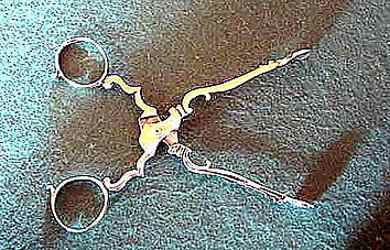
|
Fig 8: Scissors form of tea tongs first
mentioned in a Warning Carriers
(see note 8) notice of 1726.
|
A mysterious little spoon referred to in a London Gazette of
1697 as a "long tea strainer spoon with narrow pointed handle"
was introduced in about 1690. Its production persisted until the
1770s although it is mentioned in the Act of 1790
(see note 7) as not being exempt from marking. Date
letters were introduced for small spoons in 1781 and, to date,
no long tea strainer spoon has been found bearing a date letter.
As it had ceased to be used by the end of the 19th century the
way in which it was used became obscure and in the early 20th
century it was believed that it was for skimming off the tea
leaf debris that floats to the top of the tea once it has been
poured into the cup. It was given the name 'mote spoon or mote
skimmer' although it had merely been called a 'tea strainer' in
the 18th century.
The dictionary definition of the word 'mote' is "small speck"
and experimentation has shown that all but quite large debris
passes through the perforations of all but the earliest mote
spoons tried (Fig 9) so that either it has been wrongly named or
it was not used in this way at all. How these spoons were used
cannot therefore be determined with any certainty but for
convenience they continue to be called mote spoons.

|
Fig 9: Mote spoon of about 1690 by Abraham
Harache. (probably experimental)
|
By the middle of the 18th century tea was being taken in two
forms although Thomas Twining is known to have been blending tea
as early as the reign of George I by which time there were no
fewer than 20 different teas being imported to London. These two
forms were green (Hyson) tea which was that originally imported
and black (Bohea) tea which was thought to have more medicinal
properties and for this reason, presumably, tea was also eaten.
Arthur Hayden, in his book 'Chats on Old Silver' quotes from Sir
Walter Scott "A silver strainer, in which in times more
economical than our own, the lady of the house placed the
tea-leaves after the very last drop had been exhausted, that
they might hospitably be divided among the company to be eaten
with bread and butter"
(see note 9) showing that this practice was
established at least by the end of the 18th century.
These teas were sold by apothecaries and were very expensive
partly because tea was so heavily taxed. By 1784 the tax on tea
was at the rate of 119% and in 1812 whilst two ounces of coffee
cost four pence two ounces of tea would cost one shilling (three
times as much)
(see note 10).
Just as Roman soldiers were paid in salt (giving rise to the
English word salary) so 18th century serving maids were often
paid, or at least part paid, in tea and it was not uncommon for
the staff in the 'big house' to collect spent tea leaves and dry
them for re-use or re-sale. Tea caddies were produced in pairs
by this date (Fig 10) and lockable wooden boxes were being
produced in which these two varieties of tea could be kept.
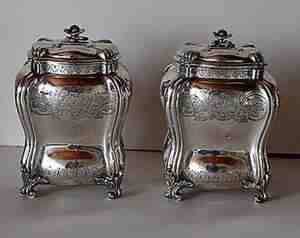
|
Fig 10: Pair of tea caddies by John Kincard
London 1756
|
As the sugar used with tea was also expensive these boxes
were often made to hold three containers, one for each of the
teas and one for the sugar, and although all three containers
could be of silver and made as a matching set it was not
uncommon for the sugar container to take the form of a glass
bowl. This has led some authorities to the erroneous belief that
this glass bowl was for blending the two teas but, whereas there
is documentary evidence that it was for sugar
(see note 11), there is no evidence that tea was ever
blended at the table. Indeed the prestige was to be able to
offer both sorts of tea to guests!
As the caddies in these lockable boxes had hinged or lift off
lids some implement would have been needed to transfer the tea
from caddy to pot. To date no designated spoon or other tool has
been identified for this purpose and for this date so that how
the tea was dispensed remains a mystery. By the end of the
century however the caddy spoon (Fig 11) had come into use but
the earliest known example dates to the 1770s.
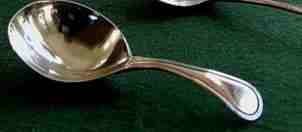
|
Fig 11: Caddy spoon by Peter and Anne Bateman -
London 1796
|
Although in later centuries such passing fancies as the tea
infuser and the tea bag have found their way into the ritual of
tea drinking it is true to say that the caddy spoon was the last
true addition to the tea equipage used by the English.
Throughout the 18th century the various items dealt with in this
survey took on the design and decorative innovations of their
time but their concept and usage did not change. Indeed, apart
from the mote spoon and possibly the kettle on stand, the
artifacts invented in that century are still in use today.
David McKinley
- 2014 -
David McKinley devotes much of his time to
researching the history of silversmithing in England
with particular reference to hallmarking at the London
office. He writes for both The Silver Spoon Club of
Great Britain and The Silver Society.
David McKinley is the author of the book THE FIRST
HUGUENOT SILVERSMITHS OF LONDON
Information about the content of this book and the
discounted price applied to members of ASCAS is
available in
September 2011 Newsletter
|
|












